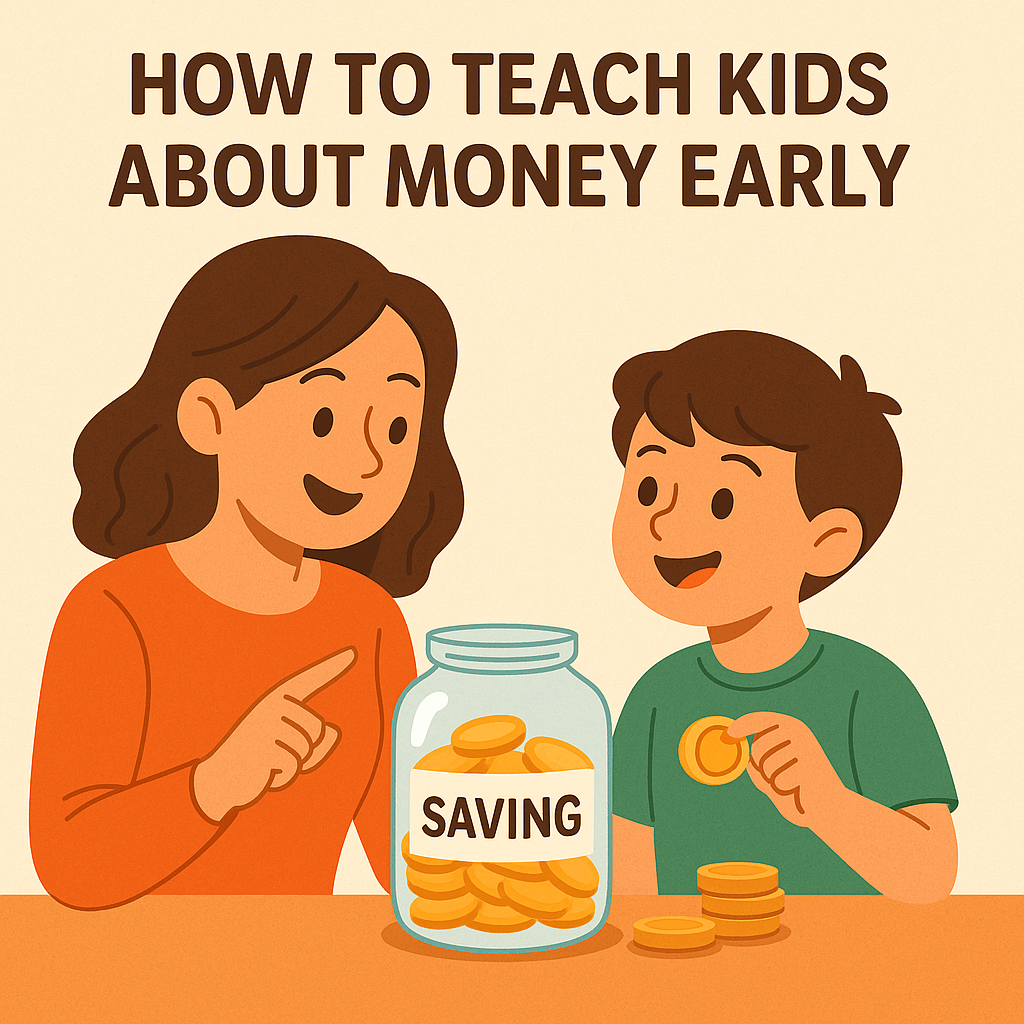Imagine if your child could grow up financially confident, responsible, and empowered. Teaching kids about money early isn’t just about coins and bills it’s about building a mindset. According to the University of Cambridge, children form financial habits by the age of 7. That’s right 7.
This guide is your powerful blueprint, curated by educators, psychologists, and financial experts, to help you raise money-smart kids. It’s packed with real-world advice, backed by research, and written with simplicity because great parenting doesn’t need jargon. Just love, clarity, and action.
Why Teaching Kids About Money Early Matters
Early lessons last forever.
Money is emotional, and how children learn about it affects their self-worth, choices, and future success. When taught with patience and positivity, financial literacy becomes a superpower.
Real-world benefits include:
-
Better decision-making (Harvard’s Center on the Developing Child)
-
Increased self-discipline
-
Higher earning potential
-
Reduced debt and financial anxiety
How to Teach Kids About Money Early
1. Start with Conversations, Not Commands
Use everyday moments like shopping or paying bills to talk about money. Kids learn by watching and asking. Instead of saying, “We can’t afford that,” try, “Let’s talk about how we choose what to spend our money on.”
Power Tip:
Create a “Money Jar Talk” once a week. Drop a topic in a jar: “What is saving?”, “What’s a need vs. want?”, or “How do banks work?” Keep it light, fun, and interactive.

2. Give Kids Money to Manage (Even a Little)
Allowances aren’t just about giving it’s about learning. A study from T. Rowe Price found that kids who manage money early are more likely to develop budgeting and saving skills as adults.
Start with a simple rule:
-
50% to spend
-
40% to save
-
10% to give
Use clear jars or digital tools like Greenlight or GoHenry to make it visual and engaging.
3. Make Saving Exciting (Yes, Really!)
Saving doesn’t have to be boring. Make it feel like a game. Use goal charts, stickers, and countdowns to teach delayed gratification.
Try This:
-
Create a “Savings Goal Poster” with a picture of what they want (e.g., bike, game).
-
Mark progress each week.
-
Celebrate milestones not just the finish line.
According to behavioral economics research, small rewards for long-term behavior build stronger habits than just telling kids to wait.
4. Turn Mistakes into Powerful Lessons
Kids will overspend. That’s good. Let them. Then, talk about it. “What could we do differently next time?” is more empowering than, “I told you so.”
This encourages critical thinking and emotional resilience, key predictors of financial well-being in adulthood (World Bank, 2021).
5. Play Money Games That Teach Without Lecturing
Gamification works. From Monopoly to digital apps like “Bankaroo” and “PiggyBot,” financial learning can be fun and memorable.
Bonus:
Use pretend stores at home. Price items. Give them play money. Let them be the customer and the cashier. It builds empathy and decision-making skills.
6. Teach by Example (Kids Mirror You)
The #1 way kids learn about money? Watching you.
-
Let them see you budget.
-
Talk about saving for goals.
-
Be honest about past mistakes, like overspending or credit card use.
This builds trust and transparency, creating a safe environment for them to ask questions.

7. Use Tech Wisely to Support Learning
We live in a digital world. Instead of resisting, harness tech to teach.
Top apps for kids’ financial literacy:
-
Greenlight (ages 8+)
-
BusyKid (ages 5+)
-
iAllowance (ages 4+)
-
RoosterMoney (ages 6+)
These apps allow you to track chores, savings, goals, and give allowances digitally all while building money confidence.
8. Encourage Giving and Gratitude
True wealth isn’t just about accumulation it’s about impact. Teach your child the joy of giving early.
Let them choose a cause they care about. Animal shelters? Sick children? Hunger? Guide them to donate a small portion regularly. It cultivates gratitude and empathy.
Fact:
Studies show that children who give are happier, more fulfilled, and socially aware.
9. Build an Entrepreneurial Spirit Early
Children are natural entrepreneurs. Whether it’s a lemonade stand, dog walking, or making crafts encourage it.
Let them:
-
Plan their project
-
Create a budget
-
Track profits
-
Learn from failures
Even if the business fails, the lessons are priceless.
10. Use Stories to Inspire
Kids connect with stories more than spreadsheets.
Read books like:
-
“Money Ninja” by Mary Nhin (ages 4–8)
-
“The Berenstain Bears’ Trouble with Money”
-
“Rock, Brock and the Savings Shock” by Sheila Bair
Stories create emotional connections that last longer than lectures.
Expert Insight
This guide has been crafted with insights from:
-
Dr. David Anderson, Clinical Psychologist at the Child Mind Institute
-
Beth Kobliner, Author of Make Your Kid a Money Genius (Even If You’re Not)
-
National Endowment for Financial Education (NEFE)
-
Peer-reviewed findings from the University of Cambridge and Consumer Financial Protection Bureau (CFPB)
The goal is to bring expertise and empathy together for content you can trust and actually use.
FAQs: Frequently Asked Questions
Q1: At what age should I start teaching my child about money?
You can start as early as age 3–4 by using coins, jars, and play-based activities. Habits start forming by age 7, so earlier is better.
Q2: Should I give my child an allowance or make them earn it?
Both can work. What’s more important is that they learn to manage it. Some parents prefer a hybrid approach base allowance for basics, extra for chores.
Q3: How do I talk to my child about debt or financial mistakes?
Be honest and age-appropriate. Use your story as a teaching moment: “I used to spend without saving, and it caused problems. Now I make better choices.”
Q4: What if I’m not good with money myself?
That’s okay! Learning together builds connection and trust. Use books and apps designed for families. You don’t need to be perfect just present.
Q5: How can I make learning about money fun?
Use games, challenges, reward charts, stories, apps, and role-playing. The key is engagement not pressure.
Final Thoughts: Raising Financially Free Kids Starts Now
Teaching kids about money early is one of the greatest gifts you can give them. It’s not about numbers. It’s about building confidence, character, and courage.
Start small. Be consistent. Keep it positive.
And remember, you’re not just raising kids you’re raising future adults who will shape the world. Let’s make sure they’re ready.














